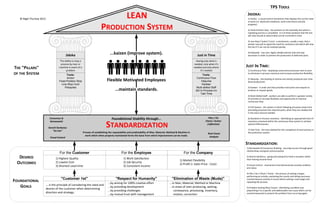Contenu connexe
Similaire à TPS Lean Production System
Similaire à TPS Lean Production System (20)
Plus de Nigel Thurlow (17)
TPS Lean Production System
- 1. For the Customer For the Employee For the Company
1) Work Satisfaction
2) Job Security
3) Consistent Income
1) Market Flexibility
2) Profit (= Sales Price - Cost)
1) Highest Quality
2) Lowest Cost
3) Shortest Lead-time
"Customer 1st" "Respect for Humanity" "Elimination of Waste (Muda)"
...by aiming for 100% creative effort
...by providing development
...by providing challenges
...by mutual trust with management
...in Man, Material, Method or Machine
...in areas of over-producing, waiting,
conveyance, processing, inventory,
motion, correction
... is the principle of considering the need and
desires of the customer when determining
direction and strategy.
LEAN
PRODUCTION SYSTEM
STANDARDIZATION
Flexible Motivated Employees
...maintain standards.
...kaizen (improve system).
Foundational Stability through...
Process of establishing the repeatability and predictability of Man, Material, Method & Machine in
work which when properly maintained forms the basis from which improvement can be made.
FOUNDATIONAL
GOALS
DESIRED
OUTCOMES
THE "PILLARS"
OF THE SYSTEM
Jidoka
The ability to stop a
process by man or
machine in event of a
problem
Tools:
Andon
Fixed-Position Stop
Line-Stop Cord
Pokayoke
Just in Time
Having only what is
needed, only when it's
needed and only where
it's needed
Tools:
Continuous Flow
Heijunka
Kanban
Multi-skilled Staff
Std In-Process Inv
Takt Time
JIDOKA:
1) Andon - a visual control mechanism that displays the current state
of work (i.e. abnormal conditions, work instructions and job
progress).
2) Fixed-Position Stop - the position on the assembly line where a
repeating process is completed. It is at these positions that the line
will stop should an abnormality not be corrected in time.
3) Line-Stop ("andon") Cord - a mechanism, usually a rope, that a
worker may pull to signal the need for assistance and which will stop
the line if it can not be resolved quickly.
4) Pokayoke - low cost, highly reliable devices that will stop
processes in order to prevent the production of defective parts.
JUST IN TIME:
1) Continuous Flow - deploying consecutive processes next to each
to eliminate in-process inventory and increase production flexibility.
2) Heijunka - the leveling of volume and variety produced over time.
(level production)
3) Kanban - A small card that provides instruction and request to
produce or request goods.
4) Multi-Skilled Staff - workers are able to perform a greater variety
of activities to increase flexibility and opportunity to improve
continuous flow.
5) Pull System - the system in which following processes draw from
preceding processes the required parts, when they are needed and
in the exact amount needed.
6) Standard In-Process Inventory - identifying an appropriate level of
inventory contained within the continuous flow system to achieve
optimal effectiveness.
7) Takt Time - the time allotted for the completion of each process in
the production system.
TPS TOOLS
Consensus &
Nemawashi
Genchi Genbutsu
"Go See"
Visual Control
Plan / Do
Check / Action
(reflection)
Root Cause
Analysis
STANDARDIZATION:
1) Nemawashi & Consensus Building - assuring success through good
relationships and good communication
2) Genchi Genbutsu - going and seeing first-hand a situation rather
than hearing second-hand
3) Visual Control - mechanisms that demonstrate visually condition
and status
4) Plan / Do / Check / Action - the process of setting a target,
performing an activity, evaluating the results and taking necessary
countermeasure activity to issues before setting a new target and
repeating the process.
5) Problem Solving (Root Cause) - identifying a problem and
pinpointing it to a specific and addressable root cause which can be
countermeasured to prevent the problem from occurring again.
© Nigel Thurlow 2012

